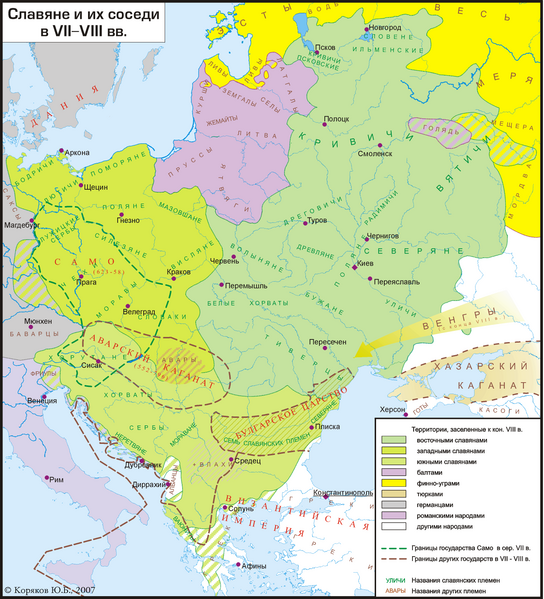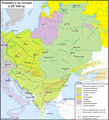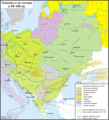File:Slav-7-8-obrez.png
מתוך Wikimedia Commons
קפיצה לניווט
קפיצה לחיפוש

גודל התצוגה המקדימה הזאת: 544 × 599 פיקסלים. רזולוציות אחרות: 218 × 240 פיקסלים | 436 × 480 פיקסלים | 698 × 768 פיקסלים | 930 × 1,024 פיקסלים | 1,860 × 2,048 פיקסלים | 3,051 × 3,359 פיקסלים.
לקובץ המקורי (3,051 × 3,359 פיקסלים, גודל הקובץ: 339 ק"ב, סוג MIME: image/png)
מידע על הקובץ
נתונים מובְנים
כיתובים
כיתובים
נא להוסיף משפט שמסביר מה הקובץ מייצג
Map of the settlement of Slavs and their neighbors at the end of the VIII century
The factual accuracy of this map or the file name is disputed.
Reason: The Byzantine presence in the Crimea and the Volokhs are erased, although they are mentioned in the Chronicle of the ancient times of the monk Nestor. This map supports an Austro-Hungarian theory of the 19th century, that of the Avar's Desert according to which the Eastern Romance languages almost disappeared for a thousand years before reappearing suddenly and massively in the 13th century. There is no reason to take here this side rather than another, and even less to consider only this one as academic to the exclusion of others. |  |
תקציר[עריכה]
| תיאורSlav-7-8-obrez.png |
Русский: Карта расселения славян и их соседей на конец VIII века. Границы некоторых государств показаны начиная с VII в. Основана в восточнославянской части в основном на археологических картах и описаниях, в частности взятых из работ В.В.Седова (в основном данные по славянам) и тома "Финно-угры и балты в эпоху средневековья" (1987) из серии Археология СССР (в основном данные по балтам и финно-уграм). Подробности добавлены в 2023 г.: в то время Венеция все еще находилась в составе Византийской империи. Авары также присутствовали вокруг Вены и в центральной Трансильвании, о чем свидетельствуют могилы и топонимы. Между албанцами и влахами существовал языковой контакт, о чем свидетельствуют неславянские слова, присутствующие в обоих языках. Поместили Этелькез мадьяр и крымских византийских греков. Южнославянские топонимы (как Трнава означает «вершина, пригорок, насыпь») свидетельствовали о южнославянском присутствии в южной Трансильвании. Что касается носителей восточного романса (называемых влахами или волохами), выбор националистической позиции, как реверта 2022 года, редуктивен: здесь нет причин показывать только теорию «А» (Awarenwüste или «Пустыня Авары» в соответствии с Франц-Джозеф Сулцер, Йозеф-Карл Эдер, Йоханн-Кристиан Фон Энгель и Эдуард-Роберт Росслер в Romänische Studien: Untersuchungen Zur älteren Geschichte rumäniens, Лейпциг 1871: видеть Béla Köpeczi, Erdély rövid története, Akadémiai Kiadó ISBN 963 05 5901 3), в котором утверждается, что влахи жили только на юге Дуная в период поздней античности и Средневековья, и исключается теория «B», которая утверждает что волохи жили только на севере Дуная (видеть Румена Даскалова и Александра Везенкова «Запутанные истории Балкан - общее прошлое, спорное наследие», том III в «Библиотеке балкановедения», Brill 2015, ISBN 9004290362). Не зная о кочевом скотоводстве, которое, по общему мнению историков, этнологов и лингвистов, было до конца Средневековья основным занятием влахов, обе теории утверждали, что Дунай и Карпаты были до XIII в., открытые границы для славян и мадьяр, но непреодолимые преграды для влахов/волохов и только для них, причем отсутствие неоспоримых доказательств их присутствия стоит доказательства отсутствия. Это относится к северному левому берегу Дуная в теории «А» и к южному правому берегу Дуная в теории «В», но иллюзия, созданная таким образом во вторичных источниках, то, что влахи исчезли на тысячу лет, чтобы впоследствии чудесным образом появиться снова (видеть Георге И. Брэтиану, «Румыны, загадка и историческое чудо», выпуски Гражданской академии, Бухарест, 2019 г., ISBN 9786068924069), является абсурдном.
English: Map of the settlement of the Slavs and their neighbors at the end of the 8th century. The borders of some states are shown starting from the 7th century. It was founded in the East Slavic part mainly on archaeological maps and descriptions, in particular, taken from the works of V.V. mainly data on the Balts and Finno-Ugric peoples). Details added 2023: Venice was still in the Byzantine Empire at this time. Avars were also present around Vienna and in central Transylvania, evidenced by graves & toponyms. There was a linguistic contact between Albanians and Vlachs, evidenced by the non-Slavic words present in both languages. Placed the Etelköz of the Magyars and the Crimean byzantine Greeks. South-Slavic toponyms (as Trnava for "tip, hillock, mound") evidenced a South-Slavic presence in southern Transylvania. Concerning the Eastern romance speakers (called Vlachs or Volokhs), to choose a nationalist positioning, as the 2022 revert, is reductive: here is no reason to show only the theory A ("Awarenwüste" or "Desert of the Avars" of Franz-Josef Sulzer, Josef-Karl Eder, Johann-Christian von Engel and Eduard-Robert Rössler in Romänische Studien: untersuchungen zur älteren Geschichte Rumäniens, Leipzig 1871: see Béla Köpeczi's Erdély rövid története, Akadémiai Kiadó ISBN 963 05 5901 3) which affirms that the Vlachs lived only on the south of the Danube during Late antiquity and High Middle ages, and to exclude the theory B which affirms that the Volokhs lived only on the north of the Danube (see Rumen Daskalov and Aleksander Vezenkov's « Entangled Histories of the Balkans - Shared Pasts, Disputed Legacies » Vol. III in Balkan Studies Library, Brill 2015, ISBN 9004290362). Unaware the pastoral nomadism which, in the general opinion of historians, ethnologists and linguists, was until the end of the Middle Ages the main activity of the Vlachs, the both theories affirming that the Danube and the Carpathians were, before the 13-th century, open borders for the Slavs and the Magyars, but impassable obstacles for the Vlachs / Volokhs and only for them, the lack of indisputable proof of their presence being worth proof of absence. This applies to the northern left bank of the Danube in the theory A and to the southern right bank of the Danube in the theory B, but the illusion thus created in the secondary sources, that the Vlachs disappeared for a thousand years to miraculously reappear afterwards (see Gheorghe I. Brătianu, "The Romanians, an enigma and historical miracle" Academia Civică Publ., Bucharest 2019, ISBN 9786068924069) is a nonsense. |
| תאריך יצירה | |
| מקור | נוצר על־ידי מעלה היצירה |
| יוצר | Koryakov Yuri |
רישיון[עריכה]
אני, בעל זכויות היוצרים על עבודה זו, מפרסם בזאת את העבודה תחת הרישיון הבא:
הקובץ הזה מתפרסם לפי תנאי רישיון קריאייטיב קומונז ייחוס-שיתוף זהה 3.0 לא מותאם.
- הנכם רשאים:
- לשתף – להעתיק, להפיץ ולהעביר את העבודה
- לערבב בין עבודות – להתאים את העבודה
- תחת התנאים הבאים:
- ייחוס – יש לתת ייחוס הולם, לתת קישור לרישיון, ולציין אם נעשו שינויים. אפשר לעשות את זה בכל צורה סבירה, אבל לא בשום צורה שמשתמע ממנה שמעניק הרישיון תומך בך או בשימוש שלך.
- שיתוף זהה – אם תיצרו רמיקס, תשנו, או תבנו על החומר, חובה עליכם להפיץ את התרומות שלך לפי תנאי רישיון זהה או תואם למקור.

|
יש ליצור מחדש את התמונה ethnographic map הזו באמצעות גרפיקה וקטורית כדוגמת קובץ SVG. לפעולה זו מספר יתרונות, כפי שניתן לקרוא (באנגלית) בדף Commons:Media for cleanup. אם ברשותכם קובץ SVG, אנא העלו אותו. לאחר מכן, החליפו תבנית זו בתבנית
{{vector version available|שם הקובץ.svg}} |
היסטוריית הקובץ
ניתן ללחוץ על תאריך/שעה כדי לראות את הקובץ כפי שנראה באותו זמן.
| תאריך/שעה | תמונה ממוזערת | ממדים | משתמש | הערה | |
|---|---|---|---|---|---|
| נוכחית | 15:13, 12 באוגוסט 2023 |  | 3,359 × 3,051 (339 ק"ב) | Gyalu22 (שיחה | תרומות) | Reverted to version as of 13:16, 23 October 2022 (UTC) Look at the atlas, don't do your own research |
| 17:43, 1 ביוני 2023 |  | 3,359 × 3,051 (309 ק"ב) | Shibbolet3579 (שיחה | תרומות) | enice was still in the Byzantine Empire at this time. Avars were also present around Vienna and in central Transylvania, evidenced by graves & toponyms. There was a linguistic contact between Albanians and Vlachs, evidenced by the non-Slavic words present in both languages. Placed the Etelköz of the Magyars and the Crimean byzantine Greeks. South-Slavic toponyms (as Trnava for "tip, hillock, mound") evidenced a South-Slavic presence in southern Transylvania. Concerning the Eastern romance spe... | |
| 13:16, 23 באוקטובר 2022 |  | 3,359 × 3,051 (339 ק"ב) | Gyalu22 (שיחה | תרומות) | Reverted bad faith edit, restored to version as of 26 July 2011. The Westermanns Atlas is an irrelevant source for the previous map, as only the Southern Carpathians are shown as possibly inhabited by the Wallachians. | |
| 15:09, 28 באפריל 2014 |  | 3,359 × 3,051 (302 ק"ב) | Spiridon Ion Cepleanu (שיחה | תרומות) | Bulgarian kingdom & east-romance vlachs according with the universitary atlases of history and the Grosser Atlas zur Weltgeschichte, dir. Hans-Erich Stier, Westermann, 1985, ISBN 3-14-10-0919-8, pp. 50, 55-57, 61 & 64. | |
| 18:27, 26 ביולי 2011 |  | 3,359 × 3,051 (339 ק"ב) | Koryakov Yuri (שיחה | תרומות) | The map's resolution is drastically decreased. Undo | |
| 04:53, 26 ביולי 2011 |  | 599 × 544 (329 ק"ב) | Spiridon Ion Cepleanu (שיחה | תרומות) | On the original version of this map, the eastern romance language-spoken populations ("Vlachs" or "Volokhs") are draw only in a little area around Sredets (today Sofia), according with only one of the POVs, called "Röslerian" (since Eduard Robert Rösler | |
| 13:52, 10 במרץ 2008 |  | 3,359 × 3,051 (339 ק"ב) | Koryakov Yuri (שיחה | תרומות) | {{Information |Description= |Source= self-made |Date=March 2008 |Author= Koryakov Yuri |other_versions= }} == Licensing == {{self|cc-by-sa-3.0}} Category:Maps of the history of Russia in Russian [[Category:Maps |
אין באפשרותך לדרוס את הקובץ הזה.
שימוש בקובץ
הדפים הבאים משתמשים בקובץ הזה:
- Atlas of Albania
- Atlas of Bosnia and Herzegovina
- Atlas of Croatia
- Atlas of North Macedonia
- Atlas of Republika Srpska
- Atlas of Serbia
- Atlas of Slovakia
- Atlas of Slovenia
- Atlas of Vojvodina
- Atlas of the Czech Republic
- User:Magog the Ogre/Multilingual legend/2022 October 21-31
- User:Magog the Ogre/Multilingual legend/2023 August 11-16
- User:Magog the Ogre/Multilingual legend/2023 June 1-10
- Category:Vyatichi
שימוש גלובלי בקובץ
אתרי הוויקי השונים הבאים משתמשים בקובץ זה:
- שימוש באתר ar.wikipedia.org
- שימוש באתר arz.wikipedia.org
- שימוש באתר azb.wikipedia.org
- שימוש באתר ba.wikipedia.org
- שימוש באתר be-tarask.wikipedia.org
- שימוש באתר be.wikipedia.org
- שימוש באתר bg.wikipedia.org
- שימוש באתר ce.wikipedia.org
- שימוש באתר cs.wikipedia.org
- שימוש באתר cv.wikipedia.org
- שימוש באתר da.wikipedia.org
- שימוש באתר de.wikipedia.org
- שימוש באתר en.wikipedia.org
צפייה בשימושים גלובליים נוספים של קובץ זה.
מטא־נתונים
קובץ זה מכיל מידע נוסף, שכנראה הגיע ממצלמה דיגיטלית או מסורק שבהם הקובץ נוצר או עבר דיגיטציה.
אם הקובץ שונה ממצבו הראשוני, כמה מהנתונים להלן עלולים שלא לשקף באופן מלא את הקובץ הנוכחי.
| רזולוציה אופקית | 236.22 dpc |
|---|---|
| רזולוציה אנכית | 236.22 dpc |